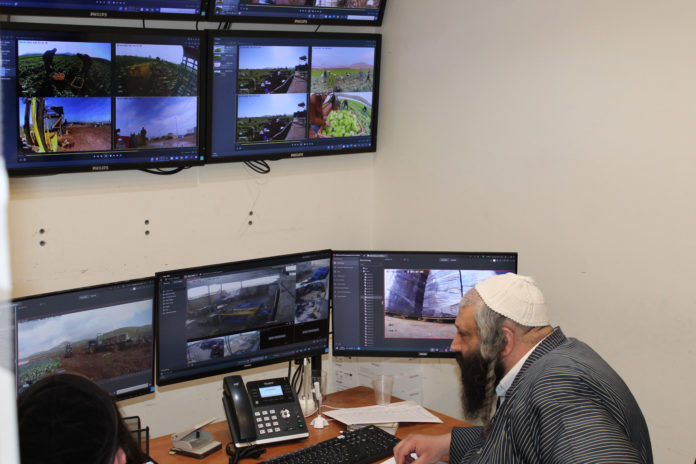I am sitting in front of a huge screen, watching high-definition drone footage of a group of men dressed in traditional Yerushalmi garb walking among Palestinians, inspecting various fields and orchards. Some security personnel lag behind them, close enough to be able to ensure the Jews’ safety. As I put the pieces of this picture together—the men in Yerushalmi garb are Badatz mashgichim; the Palestinians are the owners of the farms they are in the process of certifying—I also try to reconcile the image of the caftan-wearing yungerman next to me who is skillfully flying a hi-tech drone over an area many miles away from where we are currently sitting in the shmittah offices of the Badatz Eidah Hachareidis.
Shmittah in Eretz Yisrael causes a different kind of inflation than what we are experiencing in the United States these days. With the prohibition against working on fields and consuming produce from Jewish-owned land in Israel, a common workaround is to import produce from Europe. This naturally raises prices, so that everyday fruits and vegetables end up costing consumers more during shmittah than they would in a normal year.
But importing produce isn’t the only solution. The other way to get fruits and vegetables is to harvest them from land owned by non-Jews. The question then becomes: is the land truly owned by non-Jews, as the farmers claim? The Eidah Hachareidis has a sophisticated supervising system to track all the produce delivered to stores that have a Badatz hashgachah, verifying that it follows the Eidah’s requirements.
This sophisticated system is based in humble quarters, and I’m headed there now to see it in person. The shmittah office of the Badatz Eidah Hachareidis is located at the top of Rechov Yeshayahu, nestled near Yeshivas Brisk and the beis din of the Eidah. Walking down Rechov Malchei Yisrael toward Yeshayahu, I see a crowd standing next to some rubble, which I learn is the remainder of a hafganah (protest) that took place here the night before. Apparently, locals were protesting the opening of a cell phone store, a breach of the accepted standards in their neighborhood. The shmittah office is on the sixth floor of a typical-looking apartment building, and I breathe a sigh of relief when I see that the elevator is working—not a given for the buildings in this area.
Elazar Shisha of the Badatz, dressed in a traditional Yerushalmi caftan, greets me as I enter the office. This kind of visit to the Badatz’s shmittah office is not the norm; Elazar only granted me this peek behind the curtain because Rabbi Shmuel Chaim Soloveitchik, one of the higher-ups in the kashrus division of the Badatz, has vouched for me. Elazar is one of the people charged with monitoring the produce suppliers during the shmittah year, though he tells me that the shmittah “year” is longer than it would seem. “We actually operate for close to two years,” he says.
Elazar shows me around this apartment that has been turned into the shmittah headquarters for one of Israel’s largest kashrus organizations. It includes a conference room, an office for conducting field ownership research, a handful of cubicles, and the coup de grace, the small—and packed-to-the-max—control room. In this room, there are two Yerushalmi Yidden sitting at a desk behind four screens and various controllers. On the wall across from the desk are various monitors live streaming warehouses, fields, trucks, production plants and greenhouses. The monitors display anywhere between eight and 16 angles of different locations. Some are overhead shots, as if taken from a plane, others are still images overlooking fields, and still others are moving shots in various locations. There are two yungeleit at the desk, and Elazar introduces them to me as Yisrael and Shimon.
“No other hashgachah goes to these lengths,” Elazar says. At the same time, he emphasizes that “we don’t concern ourselves with Jewish-owned farms, fields and orchards. There are strict halachos regarding working on a field like that,





















